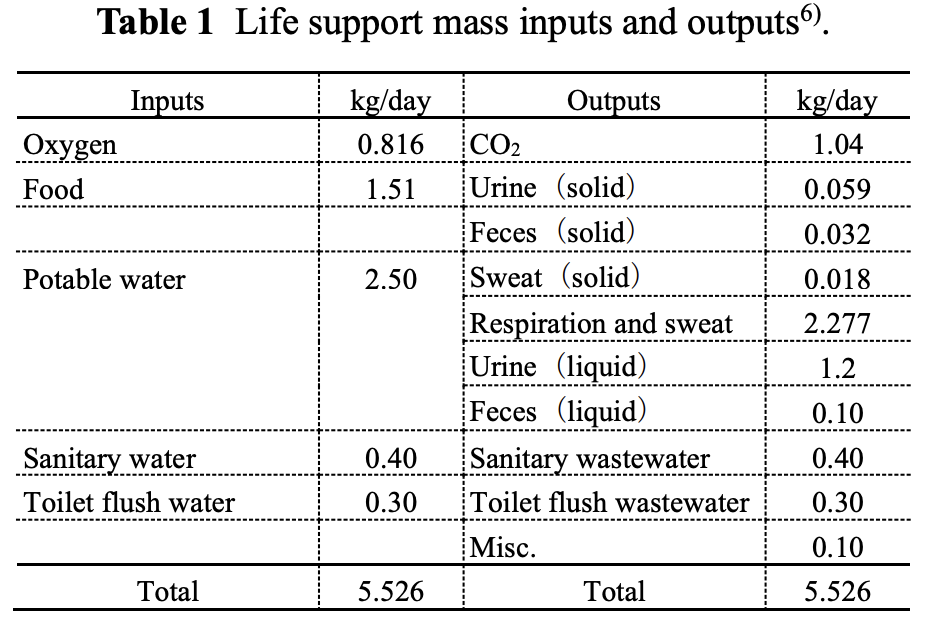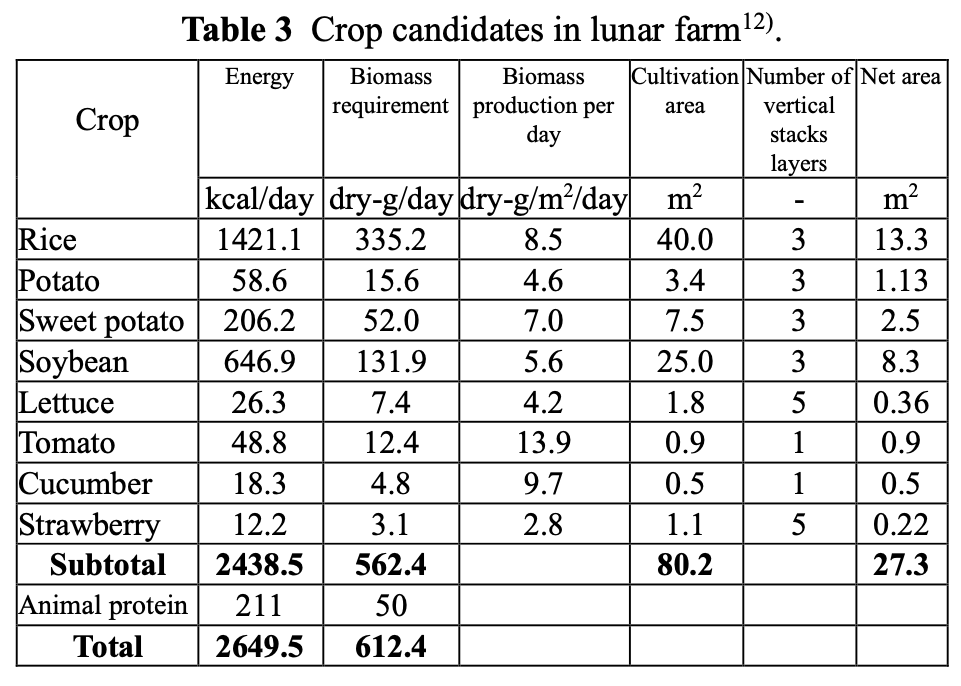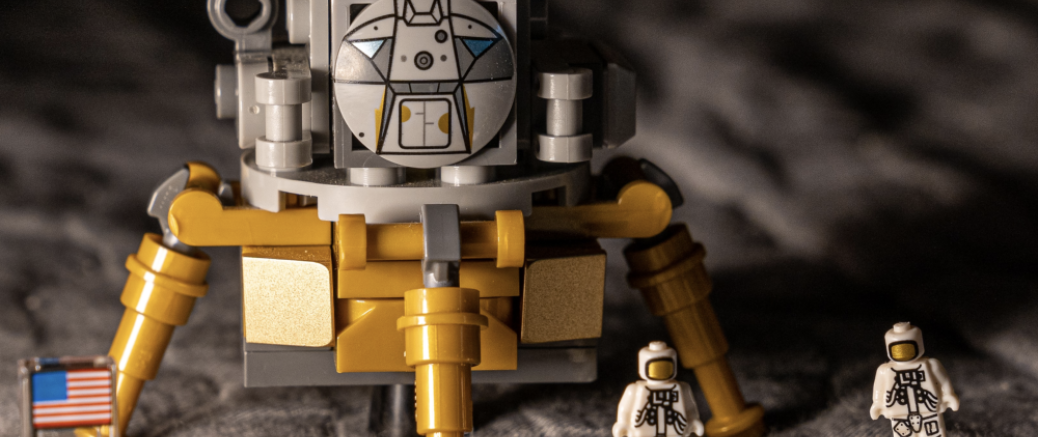To sustain life on the Moon over more than a few days, building a sustainable life support system is crucial. Challenges include lifting or producing enough resources to get the system up and running and sustaining the system cost effectively once running. Any life support system must be adequate to support all inhabitants. The following are notes and thoughts from a paper by Hiroyuki Miyajima on designing and building such a system, unless otherwise noted.1
The first challenge to setting up a permanent or long-term lunar base is getting off Earth. Since getting mass out of Earth's gravity well is incredibly energy intensive, developing in situ resource utilization is key to long-term off-planet habitation. Once on the lunar surface, oxygen, water and food must be produced and waste like CO\(_2\) and biomass recycled. Over decades, researchers have designed many systems capable of these tasks.
Comparing Life Support Systems
There are currently three types of life support systems: open - requires continuous new inputs to keep the system going closed - self-sustaining with no new inputs required hybrid - partially self-sustaining, but requiring some inputs. Each system uses a distinct set of processes to achieve its task.
Closed and hybrid systems use photosynthesis and physiochemical elements to create or recycle resources. Open systems use only non-regenerative physiochemical elements in their design. The different processes require distinct initial inputs, each with a weight cost.
Getting a closed or hybrid system to the lunar surface demands lifting more mass. Because the ongoing inputs are lower, however, they eventually catch up or surpass lighter system inputs. Environmental Support Mass (ESM) calculations, useful for comparing dissimilar systems over the same time frames, demonstrate the long-term benefits of a closed system.
\(ESM = \sum^n_{i=1} [ (M_{li}\cdot SF_{Ii})+ (V_{Ii}\cdot V_{eqi})+ (P_i \cdot P_{eqi})+\\ (C_i \cdot C_{eqi})+ (M_{TDi} \cdot D \cdot SF_{TDi})+ (CT_i \cdot D \cdot CT_{eqi}) ]\)
where \(M_{Ii}\) : initial mass of subsystem \(i\) [kg],
\(SF_{Ii}\) : initial mass stowage factor for subsystem \(i\) [kg/kg],
\(VIi\) : initial volume of subsystem i [m3 ],
\(Veqi\) : mass equivalency factor for the pressurized volume of subsystem \(i\) [kg/m3],
\(Pi\) : power requirement of subsystem \(i\) [kW],
\(Peqi\) : mass equivalency factor for the power of subsystem \(i\) [kg/kW],
\(Ci\) : cooling requirement of subsystem \(i\) [kW],
\(Ceqi\) : mass equivalency factor for the cooling of subsystem \(i\) [kg/kW],
\(M_{TDi}\) : time- or event-dependent mass of subsystem \(i\) [kg/year],
\(D\) : duration of the mission segment of interest [year],
\(SF_{TDi}\) : time- or event-dependent mass stowage factor for subsystem \(i\) [kg/kg],
\(CTi\) : crew-time requirement of subsystem \(i\) [CM-hour/year], and
\(CTeqi\) : mass equivalency factor for the crew-time of subsystem \(i\) [kg/CM-hour]
Mass equivalency factors (\(Veq, Peq, Ceq\), and \(CTeq\)) are used to convert the non-mass parameters (\(V, P, C\), and \(CT\)) to mass equivalencies.
The result in Figure 4 demonstrates the linearity of the EMS and the long-term benefits of a closed, self-sustaining system.

Populating a Closed System
Miyajima selects 8 plants to be part of the system: rice, potato, sweet potato, soybean, lettuce, tomato, cucumber, and strawberry. This differs somewhat from Katayama's 2008 suggestions, which consisted of rice, soybean, green-yellow vegetable, and sweet potato. 2 One plausible reason for the difference is the proposed system's requirement to consider dietary need, waste recycling and oxygen generation.
Nutritionally, these eight plants provide a rich balance. Rice is an important source of carbohydrates, while potatoes and sweet potatoes provide complex carbohydrates, vitamins and minerals. Soybeans are high in protein, fiber, and essential fatty acids; lettuce provides dietary fiber. Tomatoes contain antioxidants such as lycopene and cucumbers are rich in vitamin K. Strawberries offer Vitamin C.3
Miyajima's choice of plants meets the Japanese Dietary Reference Intakes recommendations for a middle-aged (30-49) man doing moderate activity. Probably the unstated assumption is that women are on average smaller and will need as much or less than the nutritional content men need.
The daily mass calculations per person comes to 5.26 kg/day (Table 1) and includes inputs and outputs of oxygen, food, potable and grey water. For a team of 6 people, a growing area footprint of 27.3 m2 suffices (Table 3), since most plants grow in vertical stacks.

Culturally, most of these plant choices should translate well to other settlements. Russians and Americans doing similar research, however, chose wheat as their primary source of starch. Wheeler (2017) also found that 11 m\(^2\) of wheat was required to produce enough O\(_2\) and scrub CO\(_2\) for 1 person (i.e. 66 m\(^2\) for a team of 6), making rice more compact at 40 m\(^2\)i (see Table 3). 4

Further Research
Taking this study further, the results from Katayama, et al., suggest augmenting plant nutrition with animal proteins as plants alone are insufficient for long-term consumption. Miyajima hints at this in his Table 3, which includes "Animal protein" without discussion. Adding loach fish accustomed to the drain/flood periodicity of rice cultivation could improve the system. Insects can also provide nutritional improvements and make breaking down biomass more efficient. 2
Another area for further calculation is in the assumptions made by Miyajima. In project management, selecting only minimal requirements is a risk. With a lunar base, the crew might run short of provisions, and any unexpected change would increase the stress on the system. A lack of food and water could, in turn, lead to illness or malnutrition. Re-calculating with a broader range of figures would be helpful to broaden the study's scope .5
-
MIYAJIMA, H. (2020). Self-Sustainable Life Support System Trade Study for Lunar Farming. International Journal of Microgravity Science and Application, 37(3), 370304. https://www.jstage.jst.go.jp/article/ijmsa/37/3/37_370304/_article/-char/ja/ ↩
-
Katayama, N., Ishikawa, Y., Takaoki, M., Yamashita, M., Nakayama, S., Kiguchi, K., ... & Force, S. A. T. (2008). Entomophagy: A key to space agriculture. Advances in Space Research, 41(5), 701-705. ↩ ↩
-
ExplainPaper.com. 2023. https://explainpaper.com. ↩
-
Wheeler, R. (2017). Agriculture for Space: People and Places Paving the Way. Open Agriculture, 2(1), 14-32. https://doi.org/10.1515/opag-2017-0002 ↩
-
Photo by Winston Chen on Unsplash ↩
